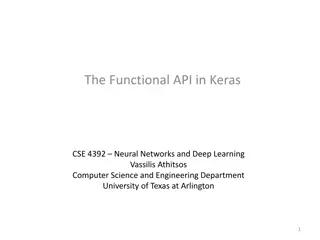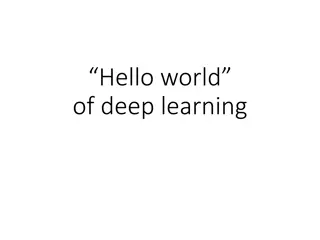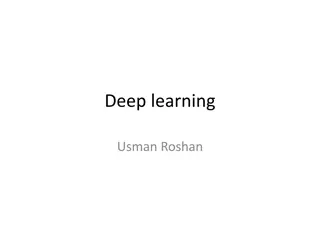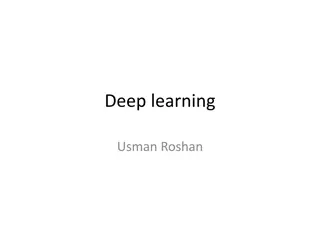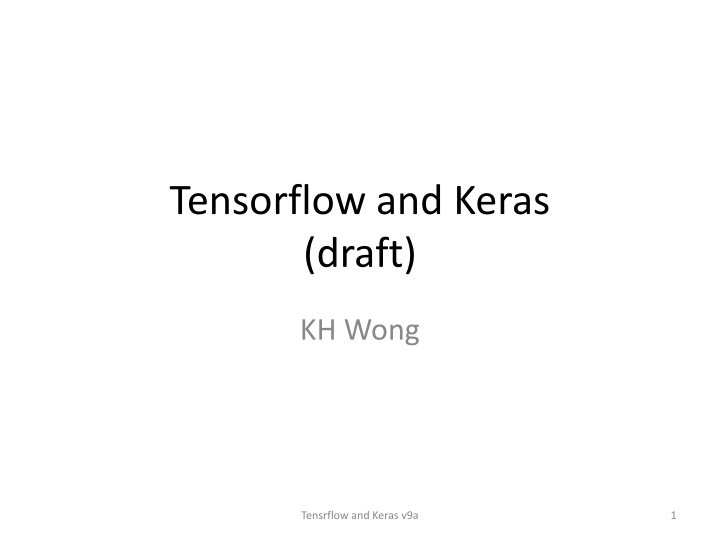
Mastering Tensorflow and Keras: Comprehensive Guide
Dive into the world of Tensorflow and Keras with this detailed guide covering installation, usage, model creation using Sequential and Functional APIs, and important tips for utilizing the latest updates. Explore the nuances of each API and unleash the full potential of deep learning models.
Download Presentation

Please find below an Image/Link to download the presentation.
The content on the website is provided AS IS for your information and personal use only. It may not be sold, licensed, or shared on other websites without obtaining consent from the author. If you encounter any issues during the download, it is possible that the publisher has removed the file from their server.
You are allowed to download the files provided on this website for personal or commercial use, subject to the condition that they are used lawfully. All files are the property of their respective owners.
The content on the website is provided AS IS for your information and personal use only. It may not be sold, licensed, or shared on other websites without obtaining consent from the author.
E N D
Presentation Transcript
Tensorflow and Keras (draft) KH Wong Tensrflow and Keras v9a 1
Introduction Why Tensor flow Why Keras How to install Tensorflow, Keras How to use Keras Tensrflow and Keras v9a 2
Keras usage Models : the Sequential model, and : the Model class used with the functional API. model.layers is a flattened list of the layers comprising the model. model.inputs is the list of input tensors of the model. model.outputs is the list of output tensors of the model. model.summary() prints a summary representation of your model. Shortcut for utils.print_summary model.get_config() returns a dictionary containing the configuration of the model. The model can be reinstantiated from its config via: Tensrflow and Keras v9a 3
Important If you use new tensorflow (from june2019, Keras is inside tensorflow) keras tensorflow.keras I.e. from keras.layers import Activation, Dense, Input #Should be replaced by from tensorflow.keras.layers import Activation, Dense, Input #E.g. typical use import tensorflow.keras as keras from tensorflow.keras.layers import Activation, Dense, Input from tensorflow.keras.layers import Conv2D, Flatten from tensorflow.keras.layers import Reshape, Conv2DTranspose from tensorflow.keras.models import Model from tensorflow.keras import backend as K from tensorflow.keras.datasets import mnist Tensrflow and Keras v9a 4
Sequential vs functional https://machinelearningmastery.com/keras-functional-api-deep-learning/ The sequential API allows you to create models layer-by-layer for most problems. It is limited in that it does not allow you to create models that share layers or have multiple inputs or outputs. The functional API in Keras is an alternate way of creating models that offers a lot more flexibility, including creating more complex models. Tensrflow and Keras v9a 5
Sequential model https://machinelearningmastery.com/keras-functional-api-deep-learning/ ..the Sequential class is created and model layers are created and added to it. from keras.models import Sequential from keras.layers import Dense model = Sequential([Dense(2, input_dim=1), Dense(1)]) Layers can also be added piecewise: from keras.models import Sequential from keras.layers import Dense model = Sequential() model.add(Dense(2, input_dim=1)) model.add(Dense(1)) Limitations: it is not straightforward to define models that may have multiple different input sources, produce multiple output destinations or models that re-use layers. Tensrflow and Keras v9a 6
Keras Functional Models 1. Defining Input from keras.layers import Input visible = Input(shape=(2,)) Connecting Layers from keras.layers import Input from keras.layers import Dense visible = Input(shape=(2,)) hidden = Dense(2)(visible) Creating the Model from keras.models import Model from keras.layers import Input from keras.layers import Dense visible = Input(shape=(2,)) hidden = Dense(2)(visible) model = Model(inputs=visible, outputs=hidden) 2. 3. Tensrflow and Keras v9a 7
Standard Network Models Multilayer Perceptron # Multilayer Perceptron from keras.utils import plot_model from keras.models import Model from keras.layers import Input from keras.layers import Dense visible = Input(shape=(10,)) hidden1 = Dense(10, activation='relu')(visible) hidden2 = Dense(20, activation='relu')(hidden1) hidden3 = Dense(10, activation='relu')(hidden2) output = Dense(1, activation='sigmoid')(hidden3) model = Model(inputs=visible, outputs=output) # summarize layers print(model.summary()) # plot graph plot_model(model, to_file='multilayer_perceptron_graph.png') Tensrflow and Keras v9a 8
Stand Multilayer Perceptron structure produced _________________________________________________________________ Layer (type) Output Shape Param # ================================================================= input_1 (InputLayer) (None, 10) 0 _________________________________________________________________ dense_1 (Dense) (None, 10) 110 _________________________________________________________________ dense_2 (Dense) (None, 20) 220 _________________________________________________________________ dense_3 (Dense) (None, 10) 210 _________________________________________________________________ dense_4 (Dense) (None, 1) 11 ================================================================= Total params: 551 Trainable params: 551 Non-trainable params: 0 Tensrflow and Keras v9a 9
Convolutional Neural Network (CNN) # Convolutional Neural Network from keras.utils import plot_model from keras.models import Model from keras.layers import Input from keras.layers import Dense from keras.layers import Flatten from keras.layers.convolutional import Conv2D from keras.layers.pooling import MaxPooling2D visible = Input(shape=(64,64,1)) conv1 = Conv2D(32, kernel_size=4, activation='relu')(visible) pool1 = MaxPooling2D(pool_size=(2, 2))(conv1) conv2 = Conv2D(16, kernel_size=4, activation='relu')(pool1) pool2 = MaxPooling2D(pool_size=(2, 2))(conv2) flat = Flatten()(pool2) hidden1 = Dense(10, activation='relu')(flat) output = Dense(1, activation='sigmoid')(hidden1) model = Model(inputs=visible, outputs=output) # summarize layers print(model.summary()) # plot graph plot_model(model, to_file='convolutional_neural_network.png') Tensrflow and Keras v9a 10
The CNN network structure produced _________________________________________________________________ Layer (type) Output Shape Param # ================================================================= input_1 (InputLayer) (None, 64, 64, 1) 0 _________________________________________________________________ conv2d_1 (Conv2D) (None, 61, 61, 32) 544 _________________________________________________________________ max_pooling2d_1 (MaxPooling2 (None, 30, 30, 32) 0 _________________________________________________________________ conv2d_2 (Conv2D) (None, 27, 27, 16) 8208 _________________________________________________________________ max_pooling2d_2 (MaxPooling2 (None, 13, 13, 16) 0 _________________________________________________________________ flatten_1 (Flatten) (None, 2704) 0 _________________________________________________________________ dense_1 (Dense) (None, 10) 27050 _________________________________________________________________ dense_2 (Dense) (None, 1) 11 ================================================================= Total params: 35,813 Trainable params: 35,813 Non-trainable params: 0 Tensrflow and Keras v9a 11
Recurrent Neural Network # Recurrent Neural Network from keras.utils import plot_model from keras.models import Model from keras.layers import Input from keras.layers import Dense from keras.layers.recurrent import LSTM visible = Input(shape=(100,1)) hidden1 = LSTM(10)(visible) hidden2 = Dense(10, activation='relu')(hidden1) output = Dense(1, activation='sigmoid')(hidden2) model = Model(inputs=visible, outputs=output) # summarize layers print(model.summary()) # plot graph plot_model(model, to_file='recurrent_neural_network.png') Tensrflow and Keras v9a 12
RNN network produced _________________________________________________________________ Layer (type) Output Shape Param # ================================================================= input_1 (InputLayer) (None, 100, 1) 0 _________________________________________________________________ lstm_1 (LSTM) (None, 10) 480 _________________________________________________________________ dense_1 (Dense) (None, 10) 110 _________________________________________________________________ dense_2 (Dense) (None, 1) 11 ================================================================= Total params: 601 Trainable params: 601 Non-trainable params: 0 _________________________________________________________________ Tensrflow and Keras v9a 13
# Shared Input Layer from keras.utils import plot_model from keras.models import Model from keras.layers import Input from keras.layers import Dense from keras.layers import Flatten from keras.layers.convolutional import Conv2D from keras.layers.pooling import MaxPooling2D from keras.layers.merge import concatenate # input layer visible = Input(shape=(64,64,1)) # first feature extractor conv1 = Conv2D(32, kernel_size=4, activation='relu')(visible) pool1 = MaxPooling2D(pool_size=(2, 2))(conv1) flat1 = Flatten()(pool1) # second feature extractor conv2 = Conv2D(16, kernel_size=8, activation='relu')(visible) pool2 = MaxPooling2D(pool_size=(2, 2))(conv2) flat2 = Flatten()(pool2) # merge feature extractors merge = concatenate([flat1, flat2]) # interpretation layer hidden1 = Dense(10, activation='relu')(merge) # prediction output output = Dense(1, activation='sigmoid')(hidden1) model = Model(inputs=visible, outputs=output) # summarize layers print(model.summary()) # plot graph plot_model(model, to_file='shared_input_layer.png') Shared Layers Model Tensrflow and Keras v9a 14
Shared Input Layer structure ____________________________________________________________________________________________________ Layer (type) Output Shape Param # Connected to ==================================================================================================== input_1 (InputLayer) (None, 64, 64, 1) 0 ____________________________________________________________________________________________________ conv2d_1 (Conv2D) (None, 61, 61, 32) 544 input_1[0][0] ____________________________________________________________________________________________________ conv2d_2 (Conv2D) (None, 57, 57, 16) 1040 input_1[0][0] ____________________________________________________________________________________________________ max_pooling2d_1 (MaxPooling2D) (None, 30, 30, 32) 0 conv2d_1[0][0] ____________________________________________________________________________________________________ max_pooling2d_2 (MaxPooling2D) (None, 28, 28, 16) 0 conv2d_2[0][0] ____________________________________________________________________________________________________ flatten_1 (Flatten) (None, 28800) 0 max_pooling2d_1[0][0] ____________________________________________________________________________________________________ flatten_2 (Flatten) (None, 12544) 0 max_pooling2d_2[0][0] ____________________________________________________________________________________________________ concatenate_1 (Concatenate) (None, 41344) 0 flatten_1[0][0] flatten_2[0][0] ____________________________________________________________________________________________________ dense_1 (Dense) (None, 10) 413450 concatenate_1[0][0] ____________________________________________________________________________________________________ dense_2 (Dense) (None, 1) 11 dense_1[0][0] ==================================================================================================== Total params: 415,045 Trainable params: 415,045 Non-trainable params: 0 Tensrflow and Keras v9a 15
Shared Feature Extraction Layer # Shared Feature Extraction Layer from keras.utils import plot_model from keras.models import Model from keras.layers import Input from keras.layers import Dense from keras.layers.recurrent import LSTM from keras.layers.merge import concatenate # define input visible = Input(shape=(100,1)) # feature extraction extract1 = LSTM(10)(visible) # first interpretation model interp1 = Dense(10, activation='relu')(extract1) # second interpretation model interp11 = Dense(10, activation='relu')(extract1) interp12 = Dense(20, activation='relu')(interp11) interp13 = Dense(10, activation='relu')(interp12) # merge interpretation merge = concatenate([interp1, interp13]) # output output = Dense(1, activation='sigmoid')(merge) model = Model(inputs=visible, outputs=output) # summarize layers print(model.summary()) # plot graph plot_model(model, to_file='shared_feature_extractor.png') Tensrflow and Keras v9a 16
Shared Feature Extraction Layer structure ____________________________________________________________________________________________________ Layer (type) Output Shape Param # Connected to =================================================================================== input_1 (InputLayer) (None, 100, 1) 0 ____________________________________________________________________________________________________ lstm_1 (LSTM) (None, 10) 480 input_1[0][0] ____________________________________________________________________________________________________ dense_2 (Dense) (None, 10) 110 lstm_1[0][0] ____________________________________________________________________________________________________ dense_3 (Dense) (None, 20) 220 dense_2[0][0] ____________________________________________________________________________________________________ dense_1 (Dense) (None, 10) 110 lstm_1[0][0] ____________________________________________________________________________________________________ dense_4 (Dense) (None, 10) 210 dense_3[0][0] ____________________________________________________________________________________________________ concatenate_1 (Concatenate) (None, 20) 0 dense_1[0][0] dense_4[0][0] ____________________________________________________________________________________________________ dense_5 (Dense) (None, 1) 21 concatenate_1[0][0] ==================================================================================================== Total params: 1,151 Trainable params: 1,151 Non-trainable params: 0 ____________________________________________________________________________________________________ Tensrflow and Keras v9a 17
Multiple Input and Output Models model = Model(inputs=[visible1, visible2], outputs=output) # Multiple Inputs from keras.utils import plot_model from keras.models import Model from keras.layers import Input from keras.layers import Dense from keras.layers import Flatten from keras.layers.convolutional import Conv2D from keras.layers.pooling import MaxPooling2D from keras.layers.merge import concatenate # first input model visible1 = Input(shape=(64,64,1)) conv11 = Conv2D(32, kernel_size=4, activation='relu')(visible1) pool11 = MaxPooling2D(pool_size=(2, 2))(conv11) conv12 = Conv2D(16, kernel_size=4, activation='relu')(pool11) pool12 = MaxPooling2D(pool_size=(2, 2))(conv12) flat1 = Flatten()(pool12) # second input model visible2 = Input(shape=(32,32,3)) conv21 = Conv2D(32, kernel_size=4, activation='relu')(visible2) pool21 = MaxPooling2D(pool_size=(2, 2))(conv21) conv22 = Conv2D(16, kernel_size=4, activation='relu')(pool21) pool22 = MaxPooling2D(pool_size=(2, 2))(conv22) flat2 = Flatten()(pool22) # merge input models merge = concatenate([flat1, flat2]) # interpretation model hidden1 = Dense(10, activation='relu')(merge) hidden2 = Dense(10, activation='relu')(hidden1) output = Dense(1, activation='sigmoid')(hidden2) model = Model(inputs=[visible1, visible2], outputs=output) # summarize layers print(model.summary()) # plot graph plot_model(model, to_file='multiple_inputs.png') Tensrflow and Keras v9a 18
Multiple Input and Output Models structure ____________________________________________________________________________________________________ Layer (type) Output Shape Param # Connected to ==================================================================================================== input_1 (InputLayer) (None, 64, 64, 1) 0 ____________________________________________________________________________________________________ input_2 (InputLayer) (None, 32, 32, 3) 0 ____________________________________________________________________________________________________ conv2d_1 (Conv2D) (None, 61, 61, 32) 544 input_1[0][0] ____________________________________________________________________________________________________ conv2d_3 (Conv2D) (None, 29, 29, 32) 1568 input_2[0][0] ____________________________________________________________________________________________________ max_pooling2d_1 (MaxPooling2D) (None, 30, 30, 32) 0 conv2d_1[0][0] ____________________________________________________________________________________________________ max_pooling2d_3 (MaxPooling2D) (None, 14, 14, 32) 0 conv2d_3[0][0] ____________________________________________________________________________________________________ conv2d_2 (Conv2D) (None, 27, 27, 16) 8208 max_pooling2d_1[0][0] ____________________________________________________________________________________________________ conv2d_4 (Conv2D) (None, 11, 11, 16) 8208 max_pooling2d_3[0][0] ____________________________________________________________________________________________________ max_pooling2d_2 (MaxPooling2D) (None, 13, 13, 16) 0 conv2d_2[0][0] ____________________________________________________________________________________________________ max_pooling2d_4 (MaxPooling2D) (None, 5, 5, 16) 0 conv2d_4[0][0] ____________________________________________________________________________________________________ flatten_1 (Flatten) (None, 2704) 0 max_pooling2d_2[0][0] ____________________________________________________________________________________________________ flatten_2 (Flatten) (None, 400) 0 max_pooling2d_4[0][0] ____________________________________________________________________________________________________ concatenate_1 (Concatenate) (None, 3104) 0 flatten_1[0][0] flatten_2[0][0] ____________________________________________________________________________________________________ dense_1 (Dense) (None, 10) 31050 concatenate_1[0][0] ____________________________________________________________________________________________________ dense_2 (Dense) (None, 10) 110 dense_1[0][0] ____________________________________________________________________________________________________ dense_3 (Dense) (None, 1) 11 dense_2[0][0] ==================================================================================================== Total params: 49,699 Trainable params: 49,699 Non-trainable params: 0 ____________________________________________________________________________________________________ Tensrflow and Keras v9a 19
Multiple Output Model # Multiple Outputs from keras.utils import plot_model from keras.models import Model from keras.layers import Input from keras.layers import Dense from keras.layers.recurrent import LSTM from keras.layers.wrappers import TimeDistributed # input layer visible = Input(shape=(100,1)) # feature extraction extract = LSTM(10, return_sequences=True)(visible) # classification output class11 = LSTM(10)(extract) class12 = Dense(10, activation='relu')(class11) output1 = Dense(1, activation='sigmoid')(class12) # sequence output output2 = TimeDistributed(Dense(1, activation='linear'))(extract) # output model = Model(inputs=visible, outputs=[output1, output2]) # summarize layers print(model.summary()) # plot graph plot_model(model, to_file='multiple_outputs.png') Tensrflow and Keras v9a 20
Multiple Output Model structure ____________________________________________________________________________________________________ Layer (type) Output Shape Param # Connected to ==================================================================================================== input_1 (InputLayer) (None, 100, 1) 0 ____________________________________________________________________________________________________ lstm_1 (LSTM) (None, 100, 10) 480 input_1[0][0] ____________________________________________________________________________________________________ lstm_2 (LSTM) (None, 10) 840 lstm_1[0][0] ____________________________________________________________________________________________________ dense_1 (Dense) (None, 10) 110 lstm_2[0][0] ____________________________________________________________________________________________________ dense_2 (Dense) (None, 1) 11 dense_1[0][0] ____________________________________________________________________________________________________ time_distributed_1 (TimeDistribu (None, 100, 1) 11 lstm_1[0][0] ==================================================================================================== Total params: 1,452 Trainable params: 1,452 Non-trainable params: 0 ____________________________________________________________________________________________________ Tensrflow and Keras v9a 21
Best Practices Consistent Variable Names. Use the same variable name for the input (visible) and output layers (output) and perhaps even the hidden layers (hidden1, hidden2). It will help to connect things together correctly. Review Layer Summary. Always print the model summary and review the layer outputs to ensure that the model was connected together as you expected. Review Graph Plots. Always create a plot of the model graph and review it to ensure that everything was put together as you intended. Name the layers. You can assign names to layers that are used when reviewing summaries and plots of the model graph. For example: Dense(1, name= hidden1 ). Separate Submodels. Consider separating out the development of submodels and combine the submodels together at the end. Tensrflow and Keras v9a 22
Example https://machinelearningmastery.com/tutorial-first- neural-network-python-keras/ # Create your first MLP in Keras from keras.models import Sequential from keras.layers import Dense import numpy # fix random seed for reproducibility numpy.random.seed(7) # load pima indians dataset dataset = numpy.loadtxt("c:\\data\\pima-indians-diabetes.csv", delimiter=",") # split into input (X) and output (Y) variables X = dataset[:,0:8] Y = dataset[:,8] # create model model = Sequential() model.add(Dense(12, input_dim=8, activation='relu')) model.add(Dense(8, activation='relu')) model.add(Dense(8, activation='relu')) model.add(Dense(1, activation='sigmoid')) # Compile model model.compile(loss='binary_crossentropy', optimizer='adam', metrics=['accuracy']) # Fit the model model.fit(X, Y, epochs=150, batch_size=10) # evaluate the model scores = model.evaluate(X, Y) print("\n%s: %.2f%%" % (model.metrics_names[1], scores[1]*100)) Tensrflow and Keras v9a 23
References https://machinelearningmastery.com/tutorial- first-neural-network-python-keras/ https://keras.io/models/about-keras-models/ Tensrflow and Keras v9a 24

